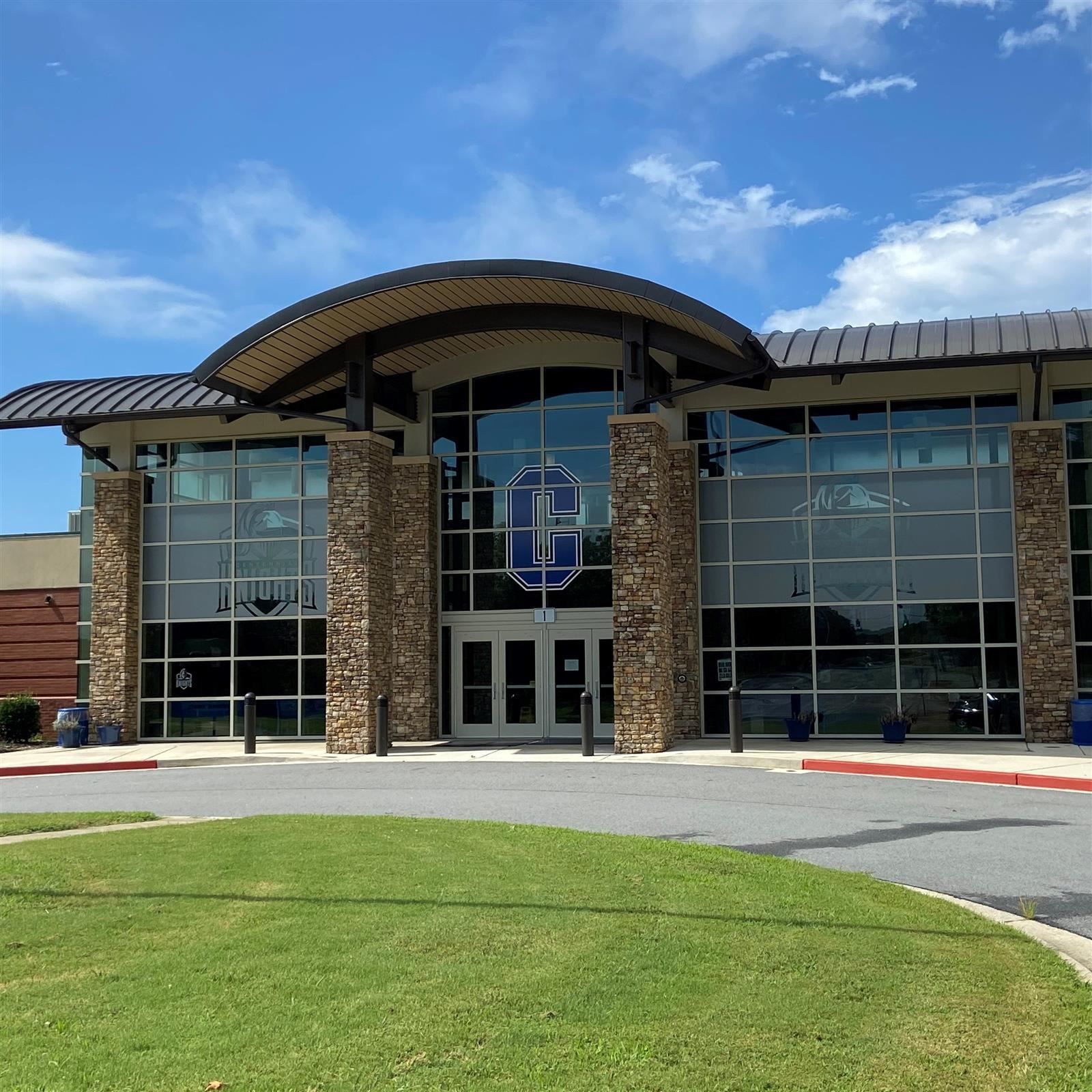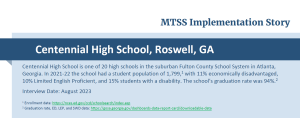Centennial High School – Roswell, GA
MTSS School Implementation Story

Centennial High School
Centennial High School is one of 20 high schools in the suburban Fulton County School System in Atlanta, Georgia. In 2021-22 the school had a student population of 1,799,1 with 11% economically disadvantaged, 10% Limited English Proficient, and 15% students with a disability. The school’s graduation rate was 94%.2
Interview Date: August 2023
Background and Catalyst
MTSS at Centennial High School (CHS) began in 2020-21 as a part of a district-wide dropout prevention impartiality initiative. During the first year, Student Support Services leaders began meeting monthly with graduation coaches across the district to ensure a common understanding of their new role as MTSS facilitators. These meetings provided a venue for sharing practices, obtaining MTSS professional learning, and problem-solving implementation challenges. In 2022-23, the district hired MTSS leaders to support school MTSS teams in developing clearly defined roles and problem-solving cultures that require the use of data and structured processes.
The Present: What Does MTSS Look Like Now?
Leadership: Vision, Teams, Structures, and Processes
The MTSS team at Centennial High School meets biweekly to discuss student data and consists of the principal, MTSS administrator, special education administrator, school social worker, instructional support teachers, school psychologist, parent liaison, counseling team, graduation coach and 504/RTI coordinator. The graduation coach and 504/RTI coordinator work closely together to plan supports for identified students and consider their partnership, along with the collaborative efforts of the MTSS team, a strength of the school’s MTSS approach. The two believe it takes a team of educators that represents the entire student population to provide them with appropriate interventions and supports to ensure their academic success and overall well-being.
Another key to Centennial’s management of MTSS has been the district’s data dashboards, which consist of academic risk reports, behavior risk reports and other dropout indicator data. The dashboards allow the MTSS team to examine students’ grades, attendance, behavior, credits, and other dropout indicators to triangulate data and set thresholds to identify students who require Tier 2 or Tier 3 support. District MTSS leaders also created a tracker that allows MTSS facilitators to analyze student data and make informed decisions about student intervention. Centennial’s MTSS team uses a green-yellow-red color-coding system to easily track student progress. During each meeting, the MTSS team uses a problem-solving model to determine whether tiered interventions are effective based on an analysis of students’ attendance, behavior, and credits (ABCs) and information from teachers, staff, interventionalists and MTSS team members.
Student Supports
Reading and math intervention for 9th and 10th graders is embedded into the students’ English and math classes. The 504/RTI coordinator began efforts to embed academic intervention in the classroom by meeting with teachers in their professional learning communities to explain RTI and help them pick a research-based intervention from the district’s intervention bank. Because most students needed support in reading comprehension, the school implemented Get the Gist in all 9th and 10th grade English classes. Teachers are expected to use the strategy with all students several times each week and track data at least every two weeks for students receiving intervention. The 504/RTI coordinator supports teachers by working with them in the classroom on using the strategy and meeting with them regularly to adjust their approach.
For math intervention, the school uses the ALEKS adaptive learning program—9th grade Algebra 1 teachers create assignments in ALEKS to help fill in gaps in students’ skills. Teachers use small groups to reteach the math concepts students are working on in ALEKS and are learning to use partner activities and group students strategically in class so they can learn from each other. The school offers small group Algebra 1 support after school and on Saturdays through an Extended Learning Program, which also provides academic support for 11th and 12th grade students who are not on track for graduation. A hybrid Extended Learning model was developed as a response to transportation challenges resulting from the impacts of COVID. In this program, the special education administrator and graduation coach work collaboratively with a team of teachers to support credit-deficient upperclassmen. Each teacher works with a caseload of 8 to 10 identified students after school, virtually and in person, to help the students recover credits.
In addition to the academic supports described above, Centennial implements a district-adopted student engagement intervention, Check & Connect, which has been a tremendous success at the school. Interviewees attributed this success in large part to the buy-in and participation of administrators, support staff, and the counseling team who were the initial Check & Connect mentors in 2020-21. As a result, they built buy-in among other staff by sharing their mentoring experiences and student success stories. The school also collaborated with the district to offer onsite training for new Check & Connect mentors. With administrative and district support, the program has flourished and expanded each year. In the 2022-23 school year, every 9th grader and most 10th graders in need of support had a trained Check & Connect mentor, and the school plans to include all mentorship, and the CHS Mentorship Program currently has more than 50 mentors from faith-based and nonprofit organizations who mentor mostly 11th and 12th graders. She asserted that community engagement has significantly impacted the school’s overall success, and the mentorship program has directly affected the school’s increased graduation rate.
Impacts of MTSS on the School
The school has seen its overall graduation rate rise from 88% in 2020 to 93.5% in 2023, and at-risk students are graduating at about the same rate as their peers. The school’s 9th grade end-of-course (EOC) data for Algebra I has also improved, with reported gains of 3.2 percentage points in the distinguished learner category and a decrease of 3.7 points in the percentage of students in the beginning learner category. Interviewees reported that both outcomes are results of the school’s MTSS implementation and highly effectively professional learning communities (PLCs).
What Challenges Did the School Encounter with MTSS Implementation?
Scheduling Academic Intervention is a Challenge
Before creating the current support structures, CHS struggled to implement academic, social emotional, and behavioral interventions. The MTSS team felt that finding time for intervention would be easier with block scheduling, but after looking into changing the master schedule, the school felt that implementing a block schedule would not be feasible. Transportation can also be a barrier to offering more intervention opportunities outside of the regular school day. Thus, the school’s MTSS leaders had to be creative by finding other ways to provide students with extra support during school hours and employing virtual support options.
Starting Small and Growing Capacity
Once they had decided that the skill-specific academic interventions required by 9th and 10th graders would need to be provided during student’s regular English and math classes, the MTSS team assessed the school’s capacity to do that and decided they would need to “start small.” In 2022-23 they focused on implementing academic intervention for 9th graders who needed it, adding 10th grade students in 2023-24. This approach was also used successfully with the Check & Connect program—once a few students and staff experienced success with the program, their experiences encouraged more staff to become mentors.
The school also started small with helping teachers provide the kind of small group academic intervention some students required in the classroom. MTSS leaders gained teacher buy-in by involving them in decision-making and providing them with flexibility in terms of how to implement the selected academic interventions. To help prevent students from feeling singled out by small group instruction, the 504/RTI Coordinator works with teachers on ways to integrate more small group work for all students, such as using more partner activities to help students with stronger and weaker skills get used to working with and helping each other.
Advice for Other Schools
Collaborate to Leverage the Knowledge of Students
The MTSS team at Centennial feels that the variety of viewpoints in MTSS meetings increases buy-in and participation in the MTSS process across the staff. Having a variety of staff, in distinct roles, engaged in the problem-solving process has helped Centennial better understand the “whys” behind academic, behavioral, and attendance struggles and find ways to customize support for each student. Knowing the “whys” helps the team determine appropriate tiers, interventions, interventionists, and support programs for all MTSS students.
Be Solution Oriented and Know Your School
Interviewees reflected on the importance that schools make MTSS frameworks their own by knowing their capacity and what will work in their context. “In FCS, each school is unique. While our students experience similar challenges, the disparity between student populations, scheduling structures and staff capacity is evident. Hence, knowing your school is essential,” said Centennial’s graduation coach. They also emphasized the value of proactively reaching out to those doing similar work at the district or school levels and asking, “What can I do? How do I do it?” They recommend that schools talk to district leaders and collaborate with their peers about how to solve problems experienced in MTSS implementation. Interviewees asserted that guidance from district leaders and collaboration with other schools has made a substantial difference in their MTSS journey.

“That community engagement piece…I think that it’s very important.”
“If you don’t have that block where you have actual intervention teachers teaching those groups of kids, it’s a huge challenge. Now it’s a capacity challenge. Do you have teachers at that high school level who are able to pull those small groups?”


This website was developed under a grant from the Department of Education through the Office of Program and Grantee Support Services (PGSS) within the Office of Elementary and Secondary Education (OESE), by the Region 6 Comprehensive Center (RC6) at the SERVE Center at UNC Greensboro under Award #S283B190055. This website contains resources that are provided for the reader’s convenience. These materials may contain the views and recommendations of various subject matter experts as well as hypertext links, contact addresses, and websites to information created and maintained by other public and private organizations. The U.S. Department of Education (ED) does not control or guarantee the accuracy, relevance, timeliness, or completeness of any outside information included in these materials. The views expressed herein do not necessarily represent the positions or policies of the U.S. Department of Education. No official endorsement by the U.S. Department of Education of any product, commodity, service, enterprise, curriculum, or program of instruction mentioned in this document is intended or should be inferred.
RC6 @ SERVE Center 5900 Summit Avenue, #201 Browns Summit, NC 27214
Copyright © 2020-2025



